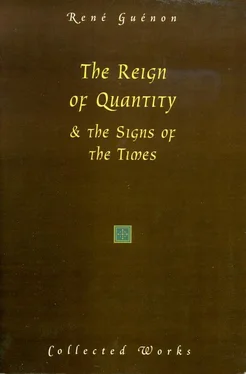The literal meaning of the Hebrew word Shayṭān is ‘adversary’, and the ‘powers’ now under consideration are truly ‘satanic’ in character.
It is opportune to add that this ‘organization of leisure’ is an integral part of the efforts referred to earlier, such as are intended to oblige men to live ‘in common’ as far as possible.
As it is one of the linguistic errors that are of common occurrence and are not without serious inconveniences, it may be useful to state clearly here that ‘duality’ and ‘dualism’ are two quite different things: dualism (of which the Cartesian conception of ‘spirit’ and ‘matter’ is among the best known examples) properly consists in regarding a duality as irreducible and in taking account of nothing beyond it, thereby denying the common principle from which the two terms of the duality really proceed by ‘polarization’.
See The Symbolism of the Cross , chap. 7.
Attention has been drawn elsewhere to a mistake of this kind in connection with the representation of the swastika with its arms turned so as to indicate opposite directions of rotation ( The Symbolism of the Cross , chap. 10).
For the same reason the Far-Eastern Dragon itself, really a symbol of the Word, has often been taken by Western ignorance to be a ‘diabolical’ symbol.
Instances can even be found in which the inverted triangles occurring among the alchemical symbols of the elements have been interpreted in that sense.
The Spiritist Fallacy and Theosophy : History of a Pseudo-Religion .
It is a question here, not so much of the more or less important part to be assigned to fraud, conscious or unconscious, but also of delusions as to the nature of the forces that intervene in the actual production of the phenomena called ‘metapsychic’.
The Two Sources of Morality and Religion .
So far as morality is concerned, it is not of special interest here, but the explanation of it proposed by Bergson is of course parallel to his explanation of religion.
It is worthy of note that Bergson seems to avoid the use of the word ‘truth’, and that he almost always uses instead the word ‘reality’, a word that in his view signifies that which undergoes continual change.
It is most regrettable that Bergson was on bad terms with his sister, Mrs S. S. L. MacGregor Mathers (alias ‘Soror Vestigia Nulla Retrorsum’) who might have been able to give him a little instruction in such matters. [S. S. L MacGregor Mathers, author of The Kabbalah Unveiled , was a leading figure in various occult organizations in the early twentieth century, primarily in England, and is known especially for his role in the founding of The Order of the Golden Dawn, whence the ‘initiatic’ name given for his wife derives. Mrs Mathers was herself very active in all these matters. For a time the Order of the Golden Dawn attracted a number of figures who became well-known in later years, including William Butler Yeats (on whom both of the Mathers exerted a strong influence for a time) and Arthur Edward Waite. Ed.]
The case of Freud himself, founder of ‘psychoanalysis’, is quite typical in this respect, for he never ceased to declare himself a materialist. One further remark: why is it that the principal representatives of the new tendencies, like Einstein in physics, Bergson in philosophy, Freud in psychology, and many others of less importance, are almost all of Jewish origin, unless it be because there is something involved that is closely bound up with the ‘malefic’ and dissolving aspect of nomadism when it is deviated, and because that aspect must inevitably predominate in Jews detached from their tradition?
It may be noted in this connection that Freud put at the head of his The Interpretation of Dreams the following very significant epigram: Flectere si nequeo superos , Acheronta movebo (Virgil, Aeneid , VII, 312).
Incidentally it was the ‘psychist’ Myers who invented the expression ‘subliminal consciousness’, which was later replaced in the psychological vocabulary for the sake of brevity by the word ‘subconscious’.
See The Spiritist Fallacy , pt. 2, chap. 10.
Another example of such means is furnished by the comparable employment of ‘radiaesthesia’, for in this case also psychic elements of the same quality very often come into play, though it must be admitted that they do not appear under the ‘hideous’ aspect that is so conspicuous in psychoanalysis.
The reader may be referred here to what has been said earlier about the symbolism of the ‘Great Wall’ and of the mountain Lokāloka .
Freud devoted a book specially to the psychoanalytical interpretation of religion, in which his own conceptions are combined with the ‘totemism’ of the ‘sociological school’.
On an attempt to apply psychoanalytical theories to the Taoist doctrine, which is of the same order as Yoga , see the study by André Préau, La Fleur d’or et le Taoïsme sans Tao [Paris: Bibliothèque Chacornac, 1931], which contains an excellent refutation of the attempted application.
See The King of the World and Spiritual Authority and Temporal Power .
According to the Islamic doctrine it is through the nafs (soul) that Shayṭān can obtain a hold on man, whereas the rūḥ (spirit), of which the essence is pure light, is beyond the reach of his endeavors.
A number of examples of activities of this kind have been given in Theosophy : History of a Pseudo-Religion .
The announcement of the destruction of Paris by fire, for example, has been promulgated several times in this way, the exact dates being specified, although nothing has ever happened, except for the impression of terror invariably aroused in many people, and never growing any less with the repeated failure of the predictions.
The relatively valid part of the predictions in question seems to be related chiefly to the function of the Mahdi and that of the tenth Avatāra ; these matters, which directly concern the preparation for the final ‘rectification’, are outside the subject of this book; all that need be mentioned now is that their very deformation lends itself to an ‘inverted’ exploitation leading toward subversion.
It must be clearly understood that this in no way means that they are the subjects of ‘hallucinations’: the difference between the meaning of the two terms is the difference between seeing things that have been consciously and voluntarily imagined by others, and imagining them oneself ‘subconsciously’.
For example, a little thought about all that has been done to throw the question of the survival of Louis XVII into inextricable confusion will give an idea of what is meant here.
Читать дальше











